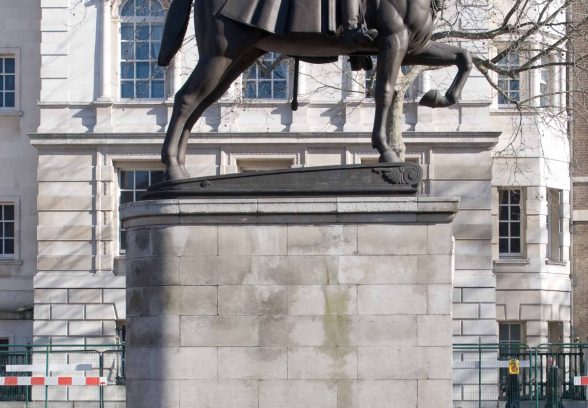This website uses cookies
This website uses cookies to enable it to function properly and to analyse how the website is used. Please click 'Close' to accept and continue using the website.




London: Haig Memorial
Status: Listed Grade II
Architect: Alfred Hardiman (Sculptor), S. Rowland Pierce (Base Designer)
Location: Whitehall, London
Earl Haig had been the Commander-in Chief of the British Armies in France from 1915-1918. A week after his death on 29th January 1928, the Prime Minister, Stanley Baldwin, proposed a statue to him. Parliament had however agreed to the memorial with no consideration for how it should look. Quickly, that decision was passed to the hands of Sir Lionel Earle and the Office of Works, which was responsible for overseeing all monuments in London’ public spaces and Royal Parks. Earle, in turn delegated the decision to the Royal Fine Art Commission – an organisation he had been instrumental in setting up in 1924. Earle was convinced of one thing, the positioning of the sculpture in Whitehall. He was quoted as saying “the position should appeal so strongly to all those soldiers on account of site proximity to the Cenotaph”. The Cenotaph was, by this point a site of huge national importance. In spite of a number of obstacles, including King George V, Earle’s view prevailed.
Earle was also responsible to limiting the number of entrants to the competition for the sculpture to just three. The three that entered were Gilbert Ledward, Alfred Hardiman and William Macmillan. As the plinth was to be a significant part of the memorial, the sculptors were obliged to each work with a different architect – Ledward with H.C Bradshaw, Hardiman with S. Rowland Pierce and Macmillan with Thomas Tait.
The winners were Hardiman and Pierce. Immediately after the commission, a sketch of the winning design appeared in the Times, unleashing a storm of controversy that dogged the sculpture up until its final unveiling in 1937. At the heart of the argument, was the horse. Derived from Hardiman’s studies of Renaissance sculpture, the horse was more classical charger than WWI cavalry, and was clearly at odds with the public perception of Haig post-WWI. Lady Haig was particularly critical of the winning design, asking why Haig could not be depicted on his own horse, Poperinghe whilst the British Legion campaigned to have the sculptor paid off and a new competition organised. Hardiman listened with quiet stoicism and altered his design several times. Eight years in the making, the sculpture was finally unveiled by the Duke of Gloucester on 10th November 1937, with the king laying a wreath the day after on Armistice Day.
The final design was surely much better than the wretched organiser of the Battles of the Somme and Passchendaele deserved. Hardiman’s bronze stands elegantly poised on a finely composed classical plinth; the horse leans forward, with one front leg raised, while horse and rider are unified by the curve of Haig’s cape. In the end it appears as if the detractors all rather missed the point as the Architectural Review pointed out, this was not a private but a national monument for which “it is essential that the statue be symbolical, and not the portrait of a gentleman on the portrait of a horse”.
Hardiman is perhaps now best remembered for this controversial sculpture to a deeply controversial figure. Other notable works include his fine, bronze Assyrian lions at the gates of Norwich City Hall (1932-38 by C. H. James and S. R. Pierce, II*) and his three sculptures, ‘Recreation’, ‘Wisdom’ and ‘Education’, at the back of the building – all 1938; his bronze of St George, originally in Carlos Place but now at Eltham Palace, and his stone carvings at County Hall in London, which comprise of four groups of statues on the Eastern side of the building. Hardiman was elected A.R.A. in 1936 and R.A. in 1944. He became a fellow of the Royal Society of British Sculptors in 1938 and the following year received their silver medal for his statue of Haig.
Gavin Stamp
Either enter the name of a place or memorial or choose from the drop down list. The list groups memorials in London and then by country

Become a C20 member today and help save our modern design heritage.